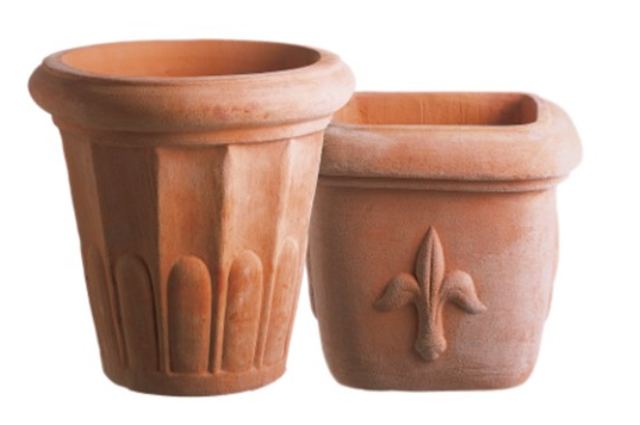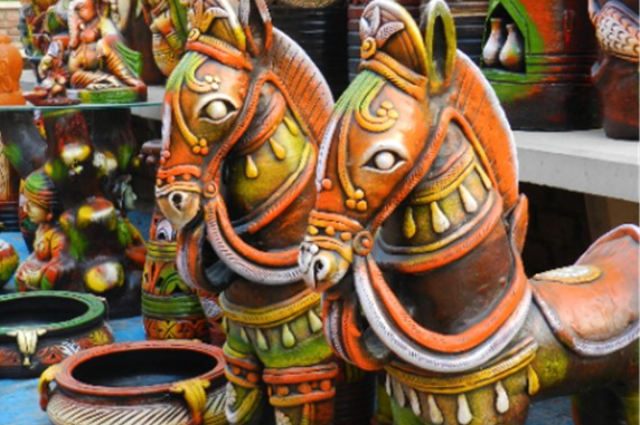
Baked Majesty in India: Introduction
“Art awakens a sense of real by establishing an intimate relationship between our inner being and the universe at large, bringing us a consciousness of deep joy.” - Rabindranath Tagore
The appeal of art to rejoice the inner creativity and emotional expression cannot be ignored by a sensible nation. Indian cultural heritage, being one of the richest in the world since ancient age, has assimilated so many forms of art. Terracotta is one of these unique methods to express the earthy glory. "Terracotta" is a word with Latin origin which means "baked earth" (Terra means earth and cotta means baked). In other words, the imprinted cast or engraved image on the soil medium is called "terracotta" when it is fired. It is the art of creating porous earthenware, sculpture, ornaments and other decorative materials from clay by drying and firing in a high temperature giving it a distinctly orange, red, brown, yellow, grey even white colour depending on the material used. It is then covered in sand to allow it to cool down. This color depends not only on the type of clay but also on the firing process. For example, if the smoke from firing is allowed to get out through the vents in the kiln, a red or orange color is obtained. On the other hand, if the vents are sealed, it gives the items a darker or black colour. Decorative pieces are either left with their original color or painted in dye to make them more attractive. Another remarkable technical aspect of terracotta is that it necessarily remains intact after baking. Even today, terracotta is still vividly used in pottery and beyond. States such as Rajasthan and Gujarat are known for their white painted terracotta pots, whereas Madhya Pradesh is famous for embellished terracotta rooftops. The present essay on the Indian terracotta craft offers the understanding of evolution as well as composition in brief with special reference to West Bengal.
Glazed & Unglazed Glory: Historical Purview
Around 3000 or 2500 years ago, terracotta used to be an influential medium of plastic activity in India. The simple yet dynamic practice to use baked brick or clay material was in vogue even before in Harappa and Mahenjodaro. The more than 2000 year history of Indian terracotta sculpture may be evaluated on the basis of two main groups - "ageless" and "evolved". Ageless form basically is the primitive one, so unchanged, where in case of evolved form, temporal is marked depending on the socio political scenario, theme, region, excavated level or undetectable data. For example, Terracotta during Satavahana reign (1st century BC - 1st century) is the timeless variety. The terracotta of this period is hollow from the inside due to the use of round and double molds. A thin layer of soil was used to be pressed into a set of two molds, one for the front and another for the back. Both parts were then joined by a fine seam of soft clay that is often visible. Many times these sculptures have holes in different parts of the body. This strategy was a highly specialized one however; it does not appear to be an exclusively local form. Rather, it may be assumed to have been imported from the Roman Empire where it was then predominant. In addition, the use of double mold terracotta in the Maurya period was prominently widespread. Furthermore, the double mold technique was also adopted during the Shunga era which was contemporary to the Satavahana dynasty in the northern part of the then India. On the other hand, if the time bound changes in the terracotta art is considered, during the Kushan dynasty, a glimpse of the amazing qualities of terracotta was evolved.
Experts in such art forms are referred to as Sculptor of earthen models (pustakiras) in an early Buddhist text after the 3rd century AD, in addition to potters (kumbhakira) and brick masons (istakavardh). Another noteworthy feature of the Kushan terracotta is the impression of the tool mark on the sculpture probably which is not unintentional. A variety of applied methods and materials were explored and used in this period such as hand modeling, tool-marks and last but not the least, the use of molds to improvise the clay sculpture. Regarding the materials used in terracotta sculpture, one of the controversial compositions is no doubt, kaolin. Kaolin is widely used in porcelain industry for glazing pottery. Probably the proper use of kaolin was unknown to Indian potters until the Muslim entrance. Major limitation of this material is that it cannot be used alone.
In contrast, ball clay, which looks a lot like Kaolin, is another secondary way. Due to its high plasticity, ball clay has the quality to withstand excessive compression during firing but high compression does not allow the image to be large in size. At the same time, the structures need to have some passages or pores for heat and puffy air to pass evenly, so that the sudden shrinking during firing cannot result in cracks. Moreover, because of its immense plastic quality, the application technique for decoration with white clay is also quite risky.
The terracotta in ball clay of the Satavahana period were done with tiny but elaborate ornamental molds, which were different from contemporary North Indian clay terracotta sculptures. Holes were made in the eyeballs, face and ear area to hide the unpleasant look. The regional black clay or red laterite form was suitable for earthen pots, probably not always very abundant. In addition, images made of white clay or kaolin bear a striking spatial resemblance to sculptures made in other part of the world, especially the Roman region. The possibility cannot be dismissed that the economic connections through trade created a taste and demand for glossy and white Roman terracotta; the regional white ball clay could simulate the attractive effect.

Source: pixabay.com
Local Lookout: Technical Heritage

Glazed Terracotta Pots
West Bengal has a rich tradition of art and craft and terracotta is one of them. In fact, rural areas of the state are a treasure trove of finely crafted terracotta items, for daily usage as well as decorative. Terracotta art in West Bengal goes back to the Mauryan period (2nd-3rd century BCE), contemporary Of Bihar. Handsome horses are a recurrent theme in Indian terracotta across states and West Bengal is no exception. Some of the well known towns for Terracotta art form are Murshidabad, Bankura, Birbhum, Midnapore (East and West), and Hooghly. After the Maurya Empire got collapsed around 200 BCE, craftsmen immigrated to the city of Chandraketugarh. The relocation influenced their style but the essence of the Maurya era persisted in the form of freestanding figures. At the site of Chandraketugarh, the most prominent example of figural plaque is at Tamluk, the then riverine Tamralipta port. The art form came to this state approximately in the sixteenth century with the influence of Vaishnavite movement which found vivid expression in Terracotta sculpting on lord Krishna temples. A popular manifestation is also observed to worship snake goddess Manasa creating a shrine constructed with tree branches, terracotta snakes and pots. Terracotta artisans of West Bengal use a mix of two or more types of clay taken from river beds and pits. These patterns are traditionally community related. The fuel used for firing is firewood, dry leaves, and twigs which are available locally. The molded items are baked in traditional kilns at temperatures of 700°-800°C. Artists work with the wheel and give the upper part of the pots or the necks a round shape. Other items like dolls, figures, jewelry, wind chimes and toys are prepared by cast and molds.
Other than toys, ornaments and home décor items, terracotta came to be used for making temples in the 15th-16th century AD. The use of bricks for creating the temples along with ornate terracotta tiles set a newer yet simple trend. The themes were taken from Puranas, Ramayana and Mahabharata epics apart from those related to everyday life. In terracotta temple architecture, traditional art perfectly blends with the imagination and expertise of the artists of the time.
As mentioned earlier, Vaishnavite movement played a great role in this regard. The popularity of this form lay in its universal and abundant availability across regions. Once the technique of baking the clay has been adopted, the way of giving permanence to the items was created. Slowly, terracotta art was put to more ambitious uses of creating accommodation and other buildings sometimes replacing stone and wood carving. Though there are many temples in West Bengal along the alluvial delta of the river Ganges, terracotta temples of Bishnupur in Bankura district are unique due to their exceptional imprint carving and sculptures. The Malla kings of Bishnupur invited scores of higher caste Hindu gentry as well as skilled potters, weavers, masons and master craftsmen for constructing the temples to perfection.
Terracotta of Bankura is one of the magnificent attempts of plastic clay modeling that has been perfected with time. The clay gets beautified when gets baked in sun or burnt in fire kilns with dry eucalyptus leaves. Terracotta has received the proud acknowledgement through Geographical Indication (GI) tag.
Department of Micro, Small and Medium Enterprises & Textiles of Government of West Bengal's, in association with The United Nations Educational, Scientific and Cultural Organization (UNESCO), has developed Rural Craft Hub and the Folk Art Centre in Panchmura village of Bankura district. The mindblowing terracotta artistry of Panchmura bears its origin in religious belief and sensitivity. The terracotta is probably the art form involving the five primary elements; Khsiti (soil), Apa (water), Tej (fire), Marut (air) and Byom (sky). The structure of the 'Bankura Horse' fascinatingly symbolizes devotion and velour. Panchmura skillfully manufactures a wide range of terracotta products from animal to human figurines as well as jewellery, toys and home décor(9). More than two hundred families in Panchmura earn livelihood by terracotta works.

Source: pixabay.com
Conclusion: The Untold Story
Mother Earth has bestowed upon us countless blessings; one is soil. Natural inspiration is an integral part of Terracotta artistry. Age old traditional wisdom and spirituality are used to get reflected in this form of art. In addition, with secular point of view, exquisite range of Terracotta kitchenware collection carries its ingenious aesthetic appeal and functionality. If the commercial wing is considered, this type of clay craft is a bit outdated in today’s world of plastic or fiber materials. Government support and promotion with some funding, recognition and an access to a wider market are gracefully essential to maintain this beautiful and significant component of the Indian culture and its identity.
. . .
References:
- Bust of the Virgin, ca. 1390–95, In Heilbrunn Timeline of Art History. New York: The Metropolitan Museum of Art, 2000–. (October 2008)
- "Definition of TERRA-COTTA" www.merriam-webster.com
- www.floma.in
- Kramrisch, Stella, 'Indian Terraccotta', JISOA, vol. XXII-XXIII, 1993- 95, pp. 14-21
- Baishali Ghosh . Technique, Time and Form in Ancient Indian Terracotta Sculptures. Towards A New Art History: Studies in Indian Art. Chapter 6, p-133-141.
- Sankalia & Dhavlikar, 'The Terracotta Art of India', Marg ,vol. XXIII, Dec., 1969, p. 43.
- Bakir, Muhammad, 'Islamic Pottery', Marg vol. XIV, 1961, p. 57.
- “The History of Terracotta in India” blog - www.ellementry.com
- A.N. Mukherjee, PORAMATIRKAAJ (Terracotta) - Linguistic Survey Of India. 2016. P-14-16
